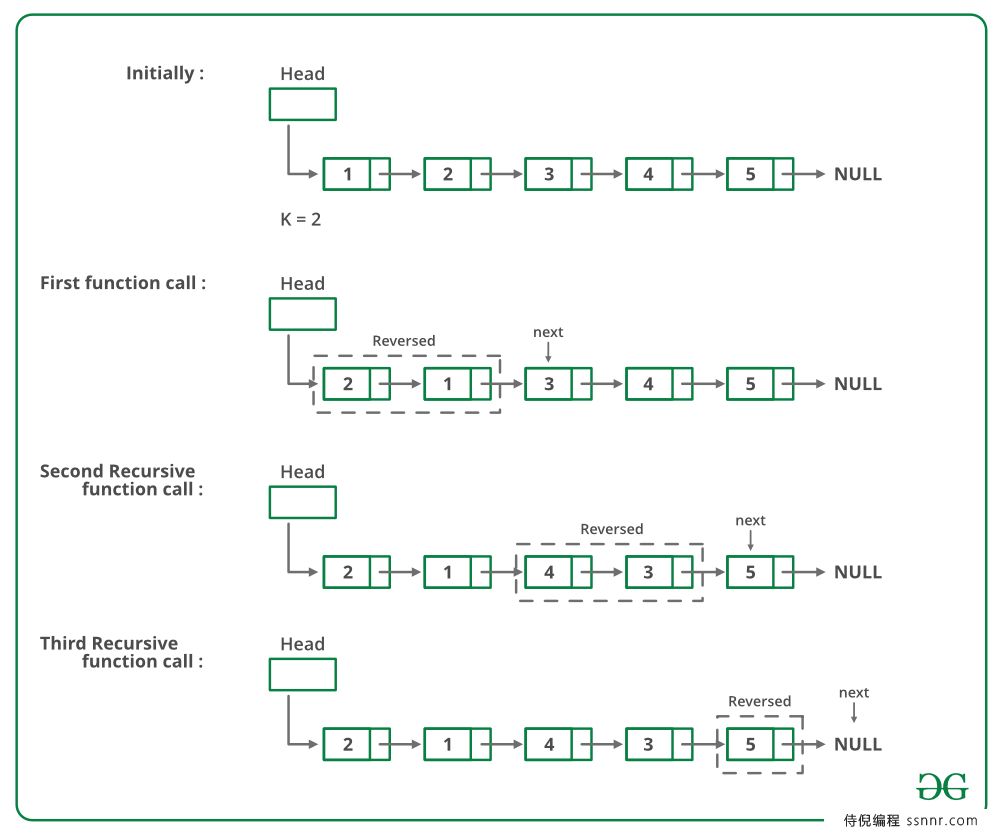C++程序 分组反转链表 – 1
给定一个链表,编写一个函数来反转每k个节点的链表(其中k是函数的输入)。
例子:
输入 : 1->2->3->4->5->6->7->8->NULL,K = 3
输出 : 3->2->1->6->5->4->8->7->NULL
输入 : 1->2->3->4->5->6->7->8->NULL,K = 5
输出 : 5->4->3->2->1->8->7->6->NULL
算法: 反转 (head, k)
- 反转第一个大小为k的子列表。反转时跟踪下一个节点和上一个节点。将指向下一个节点的指针设为 next ,将指向上一个节点的指针设为 prev 。请参见这篇文章中的反转链表
- head- >next = reverse(next, k) ( 对线路的其余部分进行递归调用,并将两个子列表链接在一起 )
- 返回 prev ( prev 成为列表的新头(请参见这篇文章的迭代方法的图解)
下面的图像显示了反转函数的工作原理:

下面是上述方法的实现:
// C ++程序反转链表
//按给定大小分组
#include <bits/stdc++.h>
using namespace std;
//链接列表节点
class Node
{
public:
int data;
Node* next;
};
/* 反转链表在组中
大小为k,并返回指针
到新的头节点。 */
Node* reverse(Node* head, int k)
{
// 基本情况
if (!head)
return NULL;
Node* current = head;
Node* next = NULL;
Node* prev = NULL;
int count = 0;
// 反转链表的前k个节点
while (current != NULL && count < k)
{
next = current->next;
current->next = prev;
prev = current;
current = next;
count++;
}
/* next现在是指向第(k+1)个节点的指针
从当前开始递归调用列表。并使列表的其余部分
作为第一个节点的下一个 */
if (next != NULL)
head->next = reverse(next, k);
// prev是输入列表的新头
return prev;
}
//实用函数
//将节点推入函数
void push(Node** head_ref,
int new_data)
{
// 分配节点
Node* new_node = new Node();
// 放入数据
new_node->data = new_data;
// 链接新节点的旧列表
new_node->next = (*head_ref);
// 将头指针移动到新节点
(*head_ref) = new_node;
}
// 打印链接列表的函数
void printList(Node* node)
{
while (node != NULL)
{
cout << node->data << " ";
node = node->next;
}
}
// 主函数
int main()
{
// 从空列表开始
Node* head = NULL;
/* 创建连接列表
1->2->3->4->5->6->7->8->9 */
push(&head;, 9);
push(&head;, 8);
push(&head;, 7);
push(&head;, 6);
push(&head;, 5);
push(&head;, 4);
push(&head;, 3);
push(&head;, 2);
push(&head;, 1);
cout << "给定链接列表 ";
printList(head);
head = reverse(head, 3);
cout << "反转链表 ";
printList(head);
return (0);
}
//这些代码由rathbhupendra贡献```
输出:
给定链接列表 1 2 3 4 5 6 7 8 9 反转列表 3 2 1 6 5 4 9 8 7
复杂度分析:
- 时间复杂度: O(n)。 只需要对列表进行一次遍历,且列表有n个元素。
- 空间复杂度: O(n/k)。 每个大小为n的链表,在递归过程中需要进行n/k或(n/k)+1次调用。
版权声明:本页面内容旨在传播知识,为用户自行发布,若有侵权等问题请及时与本网联系,我们将第一时间处理。E-mail:284563525@qq.com




